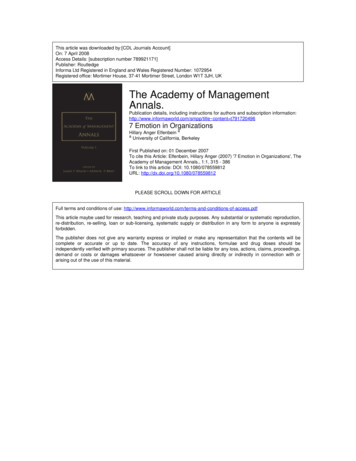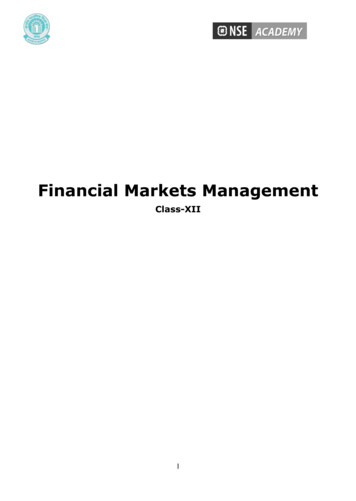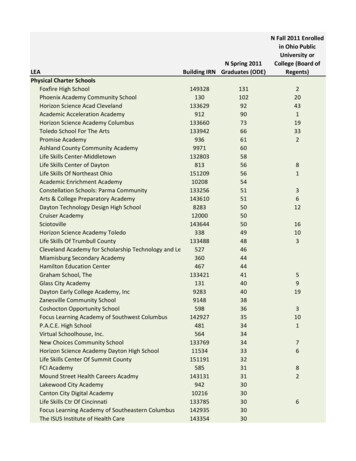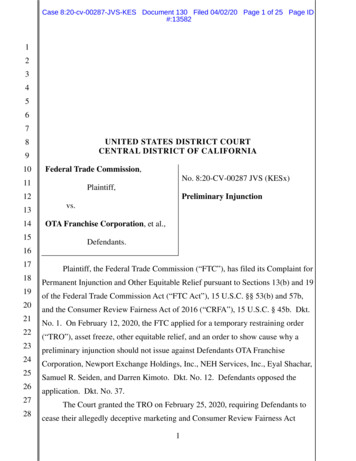
Transcription
This article was downloaded by:[CDL Journals Account]On: 7 April 2008Access Details: [subscription number 789921171]Publisher: RoutledgeInforma Ltd Registered in England and Wales Registered Number: 1072954Registered office: Mortimer House, 37-41 Mortimer Street, London W1T 3JH, UKThe Academy of ManagementAnnals.Publication details, including instructions for authors and subscription information:http://www.informaworld.com/smpp/title content t7917204967 Emotion in OrganizationsHillary Anger Elfenbein aaUniversity of California, BerkeleyFirst Published on: 01 December 2007To cite this Article: Elfenbein, Hillary Anger (2007) '7 Emotion in Organizations', TheAcademy of Management Annals., 1:1, 315 - 386To link to this article: DOI: 10.1080/078559812URL: http://dx.doi.org/10.1080/078559812PLEASE SCROLL DOWN FOR ARTICLEFull terms and conditions of use: f-access.pdfThis article maybe used for research, teaching and private study purposes. Any substantial or systematic reproduction,re-distribution, re-selling, loan or sub-licensing, systematic supply or distribution in any form to anyone is expresslyforbidden.The publisher does not give any warranty express or implied or make any representation that the contents will becomplete or accurate or up to date. The accuracy of any instructions, formulae and drug doses should beindependently verified with primary sources. The publisher shall not be liable for any loss, actions, claims, proceedings,demand or costs or damages whatsoever or howsoever caused arising directly or indirectly in connection with orarising out of the use of this material.
Downloaded By: [CDL Journals Account] At: 16:55 7 April 20087Emotion in OrganizationsA Review and Theoretical IntegrationHillary Anger ElfenbeinUniversity of California, BerkeleyAbstractEmotion has become one of the most popular—and popularized—areaswithin organizational scholarship. This chapter attempts to review and bringtogether within a single framework the wide and often disjointed literatureon emotion in organizations. The integrated framework includes processesdetailed by previous theorists who have defined emotion as a sequence thatunfolds chronologically. The emotion process begins with a focal individualwho is exposed to an eliciting stimulus, registers the stimulus for its meaning,and experiences a feeling state and physiological changes, with downstreamconsequences for attitudes, behaviors, and cognitions, as well as facial expressions and other emotionally expressive cues. These downstream consequencescan result in externally visible behaviors and cues that become, in turn, eliciting stimuli for interaction partners. For each stage of the emotion process,there are distinct emotion regulation processes that incorporate individualdifferences and group norms and that can become automatic with practice.Although research often examines these stages in relative isolation from eachother, I argue that each matters largely due to its interconnectedness with theother stages. Incorporating intraindividual, individual, interpersonal, andorganizational levels of analysis, this framework can be a starting point tosituate, theorize, and test explicit mechanisms for the influence of emotion onorganizational life.We keep coming back to feelings, I’ll have time for feelings after I’mdead. Right now we’re busy. (NASA Administrator Michael Griffin,speaking about the historic Independence Day 2006 launch of the spaceshuttle Discovery, after discussing the horror and sadness at losing the315ER6220X.indb 31511/15/07 1:19:41 PM
Downloaded By: [CDL Journals Account] At: 16:55 7 April 2008316 The Academy of Management AnnalsColumbia space shuttle in 2003, the worry leading up to the launch ofDiscovery, and the relief and pleasure at watching Discovery succeed;Boyce, 2006)IntroductionThis is an exciting time to be a researcher interested in emotion in organizations. In the wake of best-selling popular books (e.g., Goleman, 1995), as wellas the resurgence of decades-old investigations of worker sentiments (Hersey,1932), there has been heightened—indeed, often hysterical—enthusiasm frompractitioners and academics alike. This popularization has tended to elevate thestatus and legitimacy of emotion as a topic of scholarly inquiry, and has lead toa near explosion of research on the topic (Barsade, Brief, & Spataro, 2003; Brief& Weiss, 2002; Rafaeli & Worline, 2001), which represents a large-scale reversalof lay beliefs that the best way to manage emotions in the workplace is not tohave any. F. W. Taylor’s (1911) scientific management focused on machine-likeefficiency and discounted emotion because it was seen as irrational, personal,and feminine (Mumby & Putnam, 1992)—as typified in the opening quote. Bycontrast, researchers now celebrate the infusion of emotion into organizationallife (Fineman, 1996)—with implications for individual, group, and even firmperformance, as well as intricate connections to organizational phenomena asvaried as justice, diversity, power, creativity, stress, culture, and others.The explosion of research in this area has been a boon, but it has also beena mess. Popularization has led to many sweeping—yet often poorly substantiated (e.g., Goleman, 1995)—claims about the power of emotion to be harnessedfor the bottom line. The academic literature has been extensive, but often onlya loosely connected body of work with disparate themes all included under thebanner of emotion. Often research takes existing topics within managementand divides them into purportedly emotional versus nonemotional versions.At some extremes, arguments claim that nearly everything is emotion andthat it now encompasses every phenomenon heretofore studied across management and organization. One question, then, is how to articulate boundariesbecause, for emotion to mean anything, it cannot mean everything. Anotherquestion is how to integrate the study of emotion into a coherent whole.The present chapter is the first to organize a review of the research literatureon emotion in organizations around an integration of psychologists’ conceptions of the emotion process. At this point, a definition of emotion may—ormay not—be necessary. Although we tend to think that we know emotionwhen we see it, researchers have proposed a wide variety of definitions, themost widely held that emotions are adaptive responses to the demands of theenvironment (Ekman, 1992; Scherer, 1984a; Smith & Ellsworth, 1985). However, Fridlund (1994) argued that there is no formal definition of emotion thatis not tautological in some way, and he ultimately suggested that emotion ismerely a social convention for discussing behavioral intentions. At its core,ER6220X.indb 31611/15/07 1:19:41 PM
Downloaded By: [CDL Journals Account] At: 16:55 7 April 2008Emotion in Organizations 317most theorists agree that emotion is a reaction to a stimulus and has a range ofpossible consequences (Frijda, 1988). Whereas emotions typically refer to discrete and intense but short-lived experiences, moods are experiences that arelonger and more diffuse, and lack awareness of the eliciting stimulus. Moodscan be created by stimuli of relatively low intensity, or can be left behind byemotions that fade so that the initial antecedent is no longer salient (e.g.,Cropanzano, Weiss, Hale, & Reb, 2003; Schwarz, 1990). Affect is an umbrellaterm encompassing mood and emotion (Forgas, 1995).The Emotion ProcessThe integrated process framework presented here draws on processes detailedby distinguished theorists of emotion and social judgment, including Brunswik(1955), Buck (1984), Ekman (1972), Fridlund (1994), Frijda (1986; Frijda and Mesquita, 1994), Gross (2001), Scherer (1984a; 1995), Weiss and Cropanzano (1996),and others who argued for theoretical models of emotion as an interrelated seriesof processes that unfold chronologically. It incorporates important contributionsfrom psychology and allied fields such as sociology and organization studies.The goal of this chapter is to review the existing research literature onemotion in organizations systematically in terms of this process framework.Although it is beyond the scope of the chapter to review the entire underlying literature on emotion, where possible, it includes that which is illustrativeor directly relevant. It would be an overly ambitious claim for any model toaccount for absolutely every aspect of emotion studied within organizationalsettings. However, at the risk of failing, this is a first attempt to move awayfrom characterizing the vast literature as discrete topics, and to integrate itinto a single framework. To the extent that this attempt falls short, it is a starting point for further development.The emotion process begins in Figure 7.1 with intrapersonal processes whena focal individual is exposed to an eliciting stimulus, registers the stimulus forits meaning, and experiences a feeling state and physiological changes, withdownstream consequences for attitudes, behaviors, and cognitions, as well asfacial expressions and other emotionally expressive cues. Further, Frijda (1988)argued that emotions automatically trigger secondary controlled responses toregulate the emotion, which Figure 7.1 illustrates in the gray, shaded area.At each stage, regulation processes allow for individual and group norms tooverride automatic processing (e.g., Frijda, 1986; Grandey, 2000; Gross, 2001),although this distinction can blur when practice at any of these regulatedprocesses renders them overlearned and, thus, automatic (Campos, Frankel,& Camras, 2004; Gross, 1998b). Moving from intrapersonal to interpersonalprocesses, the downstream consequences of emotional experience can resultin externally visible behaviors and cues that become, in turn, the elicitingstimulus for interaction partners, as depicted in Figure 7.2. Each step of theemotion process is presented in more detail in the sections below.ER6220X.indb 31711/15/07 1:19:42 PM
Downloaded By: [CDL Journals Account] At: 16:55 7 April 2008318 The Academy of Management ing,includingcognitiveappraisal)-Feeling Rules-Feeling State-Physiology-Affect Program-Expressive StyleSituationSelection siveCuesDisplayRegulationPostemotional ResponsesAttitudesBehaviorBehavior (Action tendencies)CognitionsBehaviorFigure 7.1 Integrated Intrapersonal Process Framework for Emotion in Organizations.Note: Processes with round outlines are externally visible, whereas those in rectangles areinternally experienced. Copyright 2006, Hillary Anger Elfenbein.Although common wisdom considers emotion to be chaotic and disorganized, the emotion process is orderly, carefully sequenced, and governedby empirical regularities (Frijda, 1988). Emotions unfold chronologicallythrough a rule-governed sequence of automatic components depicted in thefigures (Frijda, 1986, 1988; Gross, 2001). The controlled components in thegray box arise at specific stages but are optional and can end at any point.Not every path is possible, and the arrows in the figures identify links previously theorized and empirically documented. These steps unfold so quicklythat they can appear together to represent a single phenomenon. However, forconceptual clarity I prefer to treat emotion more as an adjective than a noun:Each piece of the process is emotional, but no single piece on its own isemotion.Although the stages are often studied in relative isolation from each other, Iargue that each process matters largely because the other processes matter withwhich it is interconnected. For example, we care about the ability to recognizeemotional cues only because an emotional expression suggests something aboutanother person’s emotional experience, which suggests something about the other’s evaluations of the stimuli in his or her environment. Likewise, we care aboutleaders’ emotional expressions because followers interpret these expressions asimportant stimuli.The focus on individual and dyadic processes evidenced in Figures 7.1 and7.2 is in no way intended to discount the emotional role of groups, organizations, and societies. Indeed, their crucial roles are infused throughout theER6220X.indb 31811/15/07 1:19:42 PM
Emotion in Organizations 319Focal ActorDownloaded By: [CDL Journals Account] At: 16:55 7 April g,includingcognitiveappraisal)-Feeling RulesFeeling StatePhysiology-Affect Program-Expressive StyleSituationSelection ReappraisalExpressiveCuesPostemotional ResponsesAttitudesBehaviorBehavior (Action ponents RecognitionControlledComponents Decoding(Regulation) al orNote: Processes with round outlines are externally visible,whereas those in rectangles are internally experienced.Figure 7.2 Integrated Interpersonal Process Framework for Emotion in Organizations.Note: Processes with round outlines are externally visible, whereas those in rectangles areinternally experienced. Copyright 2006, Hillary Anger Elfenbein.framework, first within the norms inherent in the regulated componentsand second within the dyadic processes that can occur en masse. Thus, theframework captures multiple levels of analysis, including intraindividual,individual differences, interpersonal, and organizational processes.From a Stimulus to Emotional Registration and ExperienceStarting with William James (1884), modern psychologists have emphasizedthat emotional experience follows the perception of a stimulus. More recently,Weiss and Cropanzano’s (1996) affective events theory (AET) characterizedER6220X.indb 31911/15/07 1:19:43 PM
320 The Academy of Management AnnalsDownloaded By: [CDL Journals Account] At: 16:55 7 April 2008emotional states in the workplace as “discrete reactions precipitated by specific events” (p. 41). Thus, Figure 7.1 begins with a stimulus.StimuliA stimulus need not literally be an event that occurs, but can also be a stablefeature of the environment that is salient. Indeed, any contact between a person and his or her environment can become an affective event, particularlywhen the environment includes other people. Kelly and Barsade (2001) arguedthat greater interdependence in the modern workplace makes it contain moreintensely evocative stimuli. The asocial monotony of past work ensured thatmostly routine events arose, whereas working closely with other people bringsnew and changing stimuli. Among the greatest emotional impact for workers are those events related to interactions with coworkers, customers, andsupervisors—with leaders’ behaviors looming particularly large (e.g., Basch& Fisher, 2000; Dasborough, 2006; Gaddis, Connelly, & Mumford, 2004;Mignonac & Herrback, 2004). Although social interactions tend to be themost salient, economic events and conditions are also important emotionalelicitors (Brief & Weiss, 2002), as are a variety of environmental factors suchas temperature, noise, and aromas (Isen & Baron, 1991), and physical artifactssuch as colors and symbols (Rafaeli & Vilnai-Yavetz, 2004) that can be fleeting or chronic. Emotions also emerge from the act of engaging in work itself(Csikszentmihalyi, 1975; Sandelands, 1988), and from external factors thatcarry over to work, such as family concerns (Brief & Weiss, 2002).Beyond mechanical tasks, we relate to our work as a series of interactionsand relationships with other people (Dutton & Dukerich, 2006; Wrzesniewski, Dutton, & Debebe, 2003). Examining a range of narratives about work,Boudens (2005) found that themes of establishing and maintaining equilibriumin relationships and maintaining personal boundaries and identity tended tobe particularly evocative of emotion. Positive elicitors included work-relatedaccomplishments and overcoming obstacles, personal support, solidarity, andconnectedness. Negative elicitors included inequitable situations focusinglargely on nonfinancial compensation, discrimination, both covert and overtconflicts and power struggles, violations of norms and trust to the detrimentof other individuals or the workplace itself, ideology-based disagreements,actual or potential on-the-job death and injury, and humiliation. In Mignonacand Herrbach’s (2004) large-scale survey, the most frequent positive eventswere accomplishment and praise from supervisors and coworkers, and themost frequent negative events were being assigned undesired work, the departure of a well-liked coworker, interpersonal conflicts with supervisors andcoworkers, and the interference with work of personal problems.There is a long history of focusing on job characteristics and other environmental factors as important stimuli that influence workers’ affective states(Hackman & Oldham, 1976; Herzberg, 1966; Saavedra & Kwun, 2000). Indeed,ER6220X.indb 32011/15/07 1:19:43 PM
Downloaded By: [CDL Journals Account] At: 16:55 7 April 2008Emotion in Organizations 321many emotional experiences are related to particular job functions. Haas’(1977) steelworkers spent their days in precarious positions at great heights.Call center representatives report that they face an average of 10 customersper day who are verbally aggressive (Grandey, Dickter, & Sin, 2004). Researchand-development teams frequently face technical problems, insufficient staffing, conflict among team members, and funding shortages (Pirola-Merlo,Härtel, Mann, & Hirst, 2002). They also experience the excitement of havingcreative ideas and seeing them recognized by colleagues (Amabile, Barsade,Mueller, & Staw, 2005). Because emotions are elicited the most strongly forour most central concerns, one’s position within an organization can affect themost influential stimuli. For example, individuals low in a hierarchy expressconcerns about being treated kindly by others, whereas superiors expressconcerns about their subordinates following rules and norms (Fitness, 2000;Sloan, 2004). Annoying experiences for Disneyland theme park employeesinclude “having children and adults asking whether the water in the lagoon isreal, or where the well-marked toilets might be, or where Walt Disney’s tombis to be found, or the real clincher—whether one is ‘really real’” (Van Maanen& Kunda, 1989, p. 69).Emotional RegistrationThe attributes of an event may be objective, but meanings materialize (Weick,Sutcliffe, & Obstfeld, 2005). Including in Figure 7.1 an intervening stage in theprocess framework between the stimulus and experience does not represent astand in the long-standing debate about the primacy of affect versus cognition.On one side, Zajonc (1998) reviewed evidence that pathways in the brain viaemotional structures are faster and more direct than pathways via cognitivestructures. On the other side, cognitive appraisal and related theories arguethat we analyze the social environment for cues to determine our emotionalexperience (James, 1884; Lazarus, 1991; Schacter & Singer, 1962). However, ineither case, a direct link from stimulus to experience is not tenable because—atsome level, however minimal—a stimulus must be registered for it to evoke anemotional reaction. Even a subconscious level of awareness and processing issufficient to bring a stimulus into the emotion process (Garcia-Prieto, Bellard,& Schneider, 2003; Leventhal & Scherer, 1987; Zajonc, 1998). I label the intervening stage “emotional registration” rather than appraisal in order to incorporate both this automatic subconscious processing as well as more explicitcognitive interpretation. Even so, it is worth noting that the nomenclature of“cognitive appraisal” has tended to mislead people into a false dichotomy ofautomatic versus controlled stimulus registration—where the term cognitivehas suggested that appraisal is verbal, conscious, deliberate, logical, and slow(Ellsworth & Scherer, 2003). Even controlled appraisals tend to occur quicklyand with little awareness because they are overlearned—after all, we practiceappraising the events of greatest relevance to us, and so for relevant events theER6220X.indb 32111/15/07 1:19:43 PM
Downloaded By: [CDL Journals Account] At: 16:55 7 April 2008322 The Academy of Management Annalsprocess is likely to be well practiced. Indeed, the lack of conscious awarenessof the registration process—the sense that our emotional reactions are clearand free of subjective interpretation—often prevents individuals within organizational settings from questioning and evaluating their appraisals.There are three steps within the emotional registration process: attention,schemata, and feeling rules:Attention. The first step in emotional registration is attention—not necessarily conscious attention, but literally that the actor’s sensory organs areoriented to take in the stimulus. At its most minimal, a preconscious exposureof several hundred milliseconds may be enough to register a stimulus, but notwhen looking elsewhere. For example, placing a physical barrier to preventparticipants from seeing each other limits the impact of participants’ mood ontheir interaction partners (Carnevale & Isen, 1986; Howard & Gengler, 2001).Attention can also include deliberate attention as people learn over time whichevents are ordinary—and thus ignorable—and which are worth taking notice.Schemata. Emotional registration also involves an act of sensemaking:“What does an event mean?” (Weick et al., 2005, p. 410). In psychology, basicemotions theorists argue that we are hardwired to code events automaticallyin terms of their meaning for the self (Ekman, 1992; Frijda, 1986; Scherer,1995). The cognitive appraisal process is an ordered sequence of checkliststhat direct our attention soonest to the most pressing emotional challenges(Scherer, 1984). The initial rudimentary checks are “rapid automatic processing on a schematic level” (Scherer, 1995, p. 245) that do not require effort oreven awareness. The earliest dimension is novelty—indeed whether a stimulus is worth noting, consciously or even subliminally (Frijda, 1986; Scherer,1984a). Scherer (1995) argued that the next dimensions are the inherent pleasantness of a stimulus, its relevance to our goals, our potential for coping withthe situation, followed by others that proceed in a conditional order based onthe answers to the first set. Other theorists proposed slightly different appraisaldimensions, with the most comprehensive list including: pleasantness, attentional activity (approach vs. avoid vs. ignore), anticipated effort (active vs. passive), initial causal agent (self vs. other), current control (self vs. other vs. noone), certainty (comprehendible and predictable), perceived goal obstruction,consistency with norms or social standards, and fairness (Smith & Ellsworth,1985). This sequence has also been described as two stages, with an initial primary appraisal of pleasantness and a subsequent secondary appraisal includingall the remaining dimensions that involve more complex meaning and analysis(Lazarus, 1991). Although appraisal checks even for complex dimensions canbecome intuitive and automatic, we have the option to suspend the process inER6220X.indb 32211/15/07 1:19:43 PM
Downloaded By: [CDL Journals Account] At: 16:55 7 April 2008Emotion in Organizations 323motion—for example, taking the time to figure out whether a colleague wasserious or just kidding.Taken together, the results of these checks distinguish among five basicfamilies of emotion: approach (e.g., interest, hope, and anticipation), achievement (e.g., relief, satisfaction, contentment, pride, and joy), deterrence (e.g.,anxiety, fear, and distress), withdrawal (e.g., sadness, shame, and resignation),and antagonism (e.g., irritation, anger, and hate; Scherer & Tran, 2001). Overtime, the memory of higher order dimensions fade away as we forget about thespecific event, but moods can linger on as emotions “divorced from their antecedents” (Cropanzano et al., 2003, p. 843) with only the pleasantness dimension remaining.The emotional registration process is deeply contextualized. Being hit bya ball could be an attempted injury, clumsiness, or an invitation to play. Astrategic issue facing managers could mean a threat or an opportunity (Jackson & Dutton, 1988). Indeed, evaluations along the appraisal dimensions aresocially constructed, situation specific and—because they are in the eyes ofthe beholder—neither true or false (Zajonc, 1998). Wrzesniewski et al. (2003)argued that tasks at work do not have inherent meaning but that meaning isdeveloped around interpersonal cues from others. Thus, there is great variability in the emotional reactions that an event can invoke. For example,Scherer and Ceschi (2000) showed that the same eliciting event—the loss ofbaggage for airline passengers—evoked a range of states including anger, sadness, indifference, worry, and even humor. Although strong situations suchas mortal dangers may be interpreted consistently, the link between stimulusand experience needs to be flexible enough to accommodate the range anddiversity of human environments.Cognitive appraisal theory is underappreciated for its power to shed lighton phenomena central to organizations. The fact that we are hardwired toappraise events along these sequential dimensions suggests that the judgmentscorrespond to our most pressing concerns inside and outside of organizations.For example, Frost (2003) argued that individuals within organizations feelpain based on how their organizations appear to respond to events, rather thanthe events themselves—particularly as related to the dimensions of responsibility, fairness, certainty, control, and the ability to cope with current conditions. Likewise, procedural justice research emphasizes the importance of thefairness and control dimensions over that of valence (Lind & Tyler, 1988). Inthe domain of leadership, Dasborough’s (2006) interview study yielded a set ofcategories of leader behaviors that included awareness and respect, motivationand inspiration, empowerment, communication, reward and recognition, andaccountability—corresponding closely to many of the appraisal dimensions.Also, counterfactual thinking is likely to weigh heavily in the appraisal process,particularly given the inclusion of a certainty dimension, as we compare thestate of the world to what we expected it might be. When consideration of suchER6220X.indb 32311/15/07 1:19:43 PM
Downloaded By: [CDL Journals Account] At: 16:55 7 April 2008324 The Academy of Management Annalscounterfactuals leads to regret, it is stronger for outcomes that were under ourown control, for outcomes that resulted from action versus inaction, and forunexpected events (Mellers, 2000). Power is woven throughout the appraisalprocess, given that higher power actors are more likely to approach versusavoid, to be active versus passive, to act as initial causal agents, to be in control currently, and to enforce others’ adherence to norms and social standards(Keltner, Gruenfeld, & Anderson, 2003). Taken together, high power providesgreater flexibility to hold others accountable for negative outcomes and themselves for positive outcomes—leading to more anger and contempt versus sadness and to more pride versus gratitude (Morris & Keltner, 2000; Tiedens,2001). The appraisal dimension of fairness connects it intricately with theconcepts of justice and voice (Judge, Scott, & Ilies, 2006; Smith & Ellsworth,1985; Weiss, Nicholas, & Daus, 1999), which, by definition, are always affectiveevents. Sensemaking is an organizational construct that Weick et al. (2005)argued often accompanies an emotional experience. Thus, the chronologicallyearliest appraisal—novelty—is related to expectancy violation and thus is aprecursor to macrolevel sensemaking (Weick et al., 2005). Finally, diversitycan influence and be influenced by the appraisal process. It has been a challenge for researchers to reconcile the discrepant pattern of findings showingalternately that diversity is a help versus hindrance for individuals and groups(Williams & O’Reilly, 1998). More recently, Garcia-Prieto et al. (2003) arguedthat these conflicting findings may relate to organization members’ emotionalappraisals. First, diversity may have no effect if it is not perceived as noveland, thus, not to be appraised. Second, biases in interpreting ingroup versusoutgroup behavior and cultural differences in implicit theories such as thoseregarding control, certainty, and fit with norms can feed into the judgmentsmade for the appraisal checks. Taken together, members of diverse groups canappraise different events and can appraise the same events differently.Feeling rules. The appraisal process, like many exercises in decision making, begins with at least some sense of the desired answer. Although the processof applying appraisal dimensions to events appears to be universal across individuals and even cultural groups (Scherer & Wallbott, 1994), exactly how oneapplies them is a formula all his or her own. Feeling rules refer to the chronicgoals of the registration process. They include a sense of how one shouldfeel, including an emotional category as well as features such as intensity andduration, and can be verbally described just like any other norm (Hochschild,1979). Most often, these desired states are to experience the most positive andthe least negative affect (Frijda, 1988). In this sense, the entire field of motivation is relevant to the extent that motivatio
The Academy of Management Annals. Publication details, including instructions for authors and subscription information: . First Published on: 01 December 2007 To cite this Article: Elfenbein, Hillary Anger (2007) '7 Emotion in Organizations', The Academy of Management Annals., 1:1, 315 - 386 To link to this article: DOI: 10.1080/078559812 .










